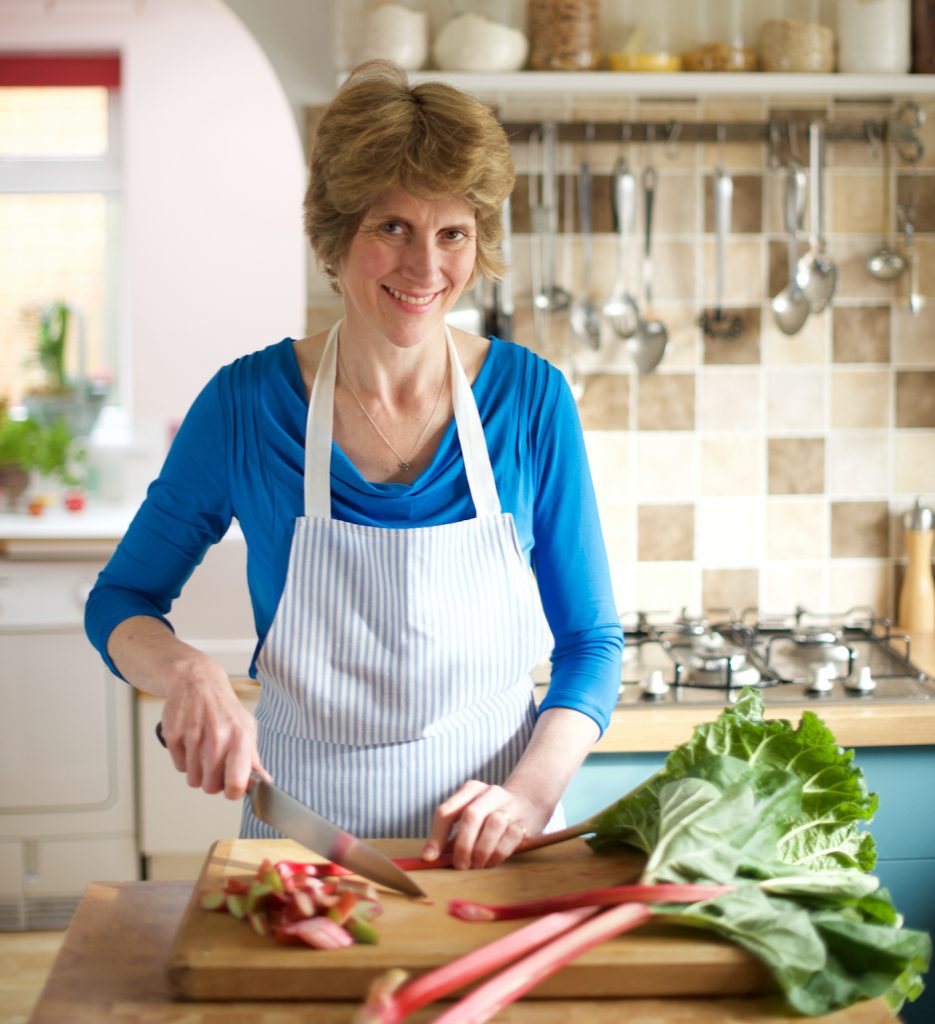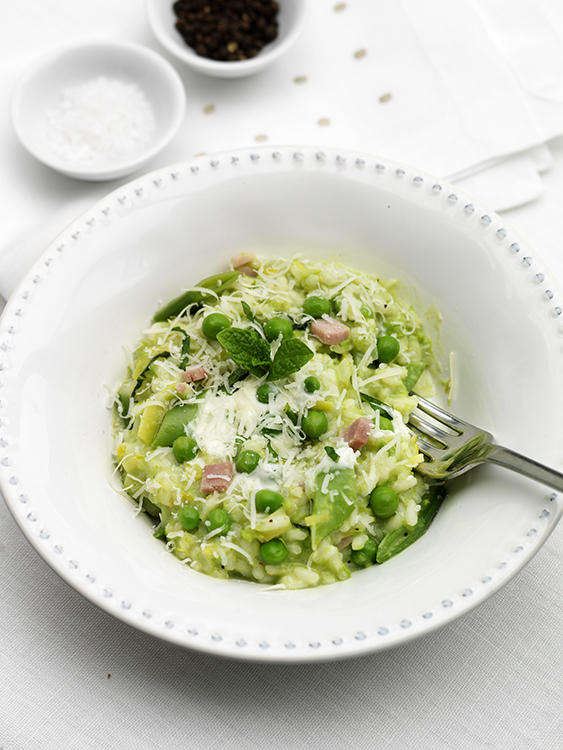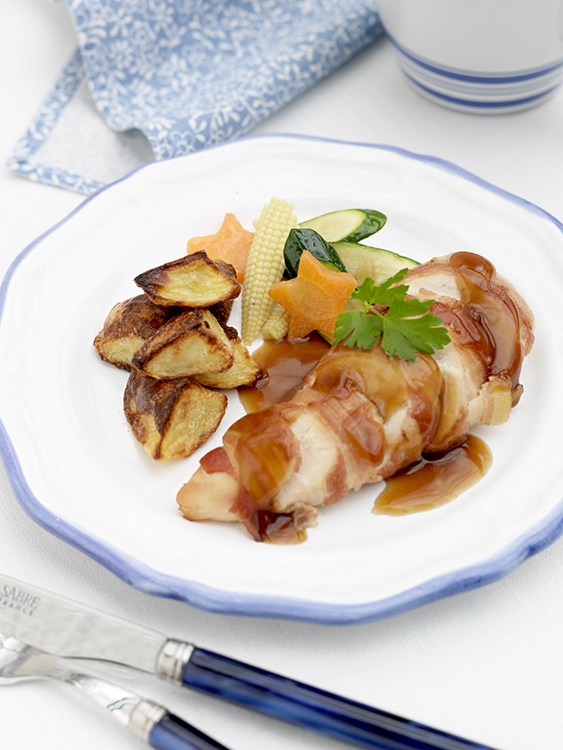Simple, Homegrown Meals Fit for a Royal Family

“We don’t talk about Bruno tonight,” joked El Encanto General Manager Janis Clapoff on a recent warm and breezy evening. She was partially making reference to the Oscar award-winning animated film Encanto, but also referring to the hotel’s Executive Chef Bruno Lopez, who was taking the night off as head chef and serving as sous-chef to the evening’s guest chef, Carolyn Robb.
In the hotel’s newly installed chef’s garden under twinkling lights, guests enjoyed an intimate farm-to-table culinary experience featuring goat cheese and ricotta soufflé sweet peppers, spring pea and crispy prosciutto salad with avocado dressing, filet of chicken, wild mushroom arancini, and salmon dressed with garden-herb gremolata served with a savory creamed celeriac with chives and wilted baby chard, lemon possets, Eton mess, and sticky toffee pudding. In between courses, the South African-born chef discussed the complexity of each dish and answered guests’ questions about perhaps one of her most important roles in the kitchen.
Robb isn’t just any chef. For 13 years, she served as a culinary master to Their Royal Highnesses, The Prince and Princess of Wales, and their young sons William and Harry, creating everything from intimate family meals to formal events at some of the most beautiful palaces the royals have called home. According to Robb, her role was to keep up with royal standards on healthy and sustainable meal making.
“Prince Charles prefers simple, contemporary, fresh ‘farm to table’ cuisine, which by definition is a healthy, seasonal diet,” Robb said.
When Robb isn’t teaching her classic-meets-contemporary culinary style, she’s writing cookbooks about her time with the royal family, including The Royal Touch: Simply Stunning Home Cooking from a Royal Chef (Abe Books, 2015) and Tea at the Palace: A Cookbook: 50 Delicious Afternoon Tea Recipes (White Lion Publishing, 2022). Her forthcoming cookbook, Christmas at the Palace (Simon & Schuster, October 2022), is an homage to the royal family and other culinary influences.
The Montecito Journal recently caught up with Chef Robb to discuss contemporary, farm-to-table-style cooking for a royal family.
Q. British cooking has experienced a renaissance in recent decades, with the elevation of traditional dishes such as Shepherd’s Pie, Bangers and Mash, and even Fish and Chips at hip gastro pubs, and creative cuisine by a new generation of chefs at exciting and bold eateries like St. John Bread and Wine in London. Can you elaborate a bit on recent changes in Great Britain’s culinary scene?
A. Britain is a melting pot of so many wonderful ethnic cuisines and this has undoubtedly elevated restaurant food to a whole new level. In addition to this, the availability of so many fantastic ingredients allows the home cook to be more adventurous. We are now all so much more aware of the importance of the providence of the food that we eat than we were even five years ago. An awareness of food miles, the traceability of the food that we eat, and also the sustainability of its production, has led many to shop for locally produced ingredients and eat with the seasons, which means that ultimately, we are all eating a better diet.
What was the process of menu planning and how involved was the royal family in your menu selections?
Menus were selected by family members from a menu book in which I would write suggestions for lunch and dinner each day. Menus were always inspired by, and planned, according to what was in season, and in particular what fruit and vegetables were growing in the garden at any time. When planning any menu, it is always best to start with what ingredients are locally available and are in season, as that is when they are at their best.
What were some royal favorites?
Prince Charles was never happier than when eating freshly picked fruit, vegetables, and salad from his organic garden. He loved a good risotto. One of Princess Diana’s favorites was minted lamb cutlets served cold with salad and a baked potato. For dessert, Princess Diana loved nothing more than a bowl of freshly prepared fruit salad made from fresh berries, sliced orange, apple, banana, grapes, pear, and some very finely shredded mint. When William and Harry were young, sausages and mash with gravy was definitely one of their favorites. Other nursery fare they enjoyed included Shepherd’s Pie and roasted chicken.
How did you play a role (or participate) in the modernizing of royal cooking during your tenure?
As their chef I did not influence what they ate, I just worked as creatively as possible to present food that was as attractive in its presentation and delicious. Wherever we were based, be it London, Highgrove House, or other locations within the UK, we always used local butchers, fishmongers, greengrocers. Prince Charles always loved to serve his own home-grown produce to his guests, and I loved cooking with such fabulous fresh ingredients. It was a great privilege to cook for two people who were so passionate about food and were also always so generous in their appreciation of it.
Prince Charles was incredibly ahead of the times with Duchy Home Farm, converting 900 acres of his Highgrove House estate into organic farming in the mid ‘80s and farm-to-doorstep initiative in the late ‘90s. It was around the same time Alice Waters created the Chez Panisse Foundation (1996) and the Edible Schoolyard program in the U.S. What was that experience like for you as his personal chef?
[Prince Charles] was ahead of his time in that he realized the enormous importance of organic farming methods, sustainability, traceability, and good animal husbandry. I was so fortunate to have access to such wonderful, organic, home-grown fresh produce; it made menu planning a joy. The Highgrove House chapter [in my book], in particular, brings back memories of the joy of walking into the garden to pick fresh produce, rather than picking up the phone to place an order with a greengrocer.
The following are some recipes from Chef Robb’s royal menu that you can prepare and enjoy in your home.
Pea and Ham Risotto
In this recipe I have introduced a very ‘English’ pairing of ingredients, peas and ham, into some risotto: one of the great cornerstones of Italian gastronomy. I love the vibrant colors and delicate flavors of this combination. There are some wonderfully evocative Italian terms for the various stages of making a risotto.
Sofrito is the sautéed garlic and onion to which the rice is added. Tostatura is the process of cooking the rice in the garlic, onion, and butter to coat each grain with a film of fat. Mantecatura is the vigorous beating in of butter and Parmesan just before serving, to give the risotto a silky richness and to make it all’onde – “flow in waves.”

Yield: Serves 4, generously
Ingredients:
12 oz frozen peas (2 cups)
A handful of sugar snaps
4 oz unsalted butter (1 stick)
1 onion
1 small leek
1 clove of garlic
8 oz Carnaroli risotto rice (1 cup)
1 cup dry white wine
4 1/2 cups chicken stock
2 oz freshly grated Parmesan (1/2 cup)
4 oz diced ham (3/4 cup)
4 sprigs of mint
4 tbsp crème fraîche
Directions:
1. Cook the frozen peas in boiling, salted water until tender. Do not overcook as they will lose their vibrant green color. Drain and reserve a little of the water they were cooked in.
2. Set aside 1/4 cup of the peas. Using a stick blender or liquidizer blend the remaining peas to a smooth purée, adding about 4 tablespoons of the cooking water and 30g (2 tablespoons) of butter. Season with salt and freshly ground black pepper. Keep on one side.
3. Cook the sugar snaps lightly, so that they are still crisp, and set aside with the remaining peas, to use for garnishing the risotto.
4. Remove the tough outer layers from the leek, then chop it finely. If it is at all muddy, place it in a colander or sieve and rinse it under cold running water, drain well.
5. Peel and finely chop the onion and crush the garlic.
6. In a heavy-based, deep saucepan, melt 3 tablespoons of butter and add the onion, leek, and garlic. Cook until it is very soft and starting to color. This is your sofrito.
7. Add the rice to the sofrito and stir well.
8. Next the tostatura stage; cook the rice gently with the buttery onions and garlic for a couple of minutes to ensure that each grain is coated in butter.
9. Add the white wine and cook rapidly. Continue stirring until the liquid has mostly evaporated.
10. Bring the stock to a simmer in a separate saucepan.
11. Add the stock to the rice ladle by ladle. Cook over a low heat, stirring constantly. Once most of the stock has been absorbed, add the next ladleful.
12. It is important to keep stirring the rice as this helps to release its starchy coating while also allowing the harder kernel to gently swell and soften, and it is this that gives a silky texture to the risotto.
13. Carnaroli rice will take 15 – 18 minutes to cook. Arborio may take a bit longer. Check the package instructions for precise timings.
14. Taste the risotto from time to time to see if the rice is tender. Traditionally it should be served with a little bit of ‘bite’ to it. You may not need to use all of the stock.
15. Add the pea purée, peas, sugar snaps, and diced ham to the risotto. Heat it through quickly, but do not cook for too long or the color will lose its vibrancy. The risotto should ‘flow’; it should be all’onde. If it doesn’t slip off a spoon easily then add more hot stock to it.
16. You have now reached the mantecatura stage; vigorously stir in the remaining butter and all but 2 spoons of the Parmesan, for a wonderfully creamy finish to the risotto.
17. Spoon a dollop of crème fraîche onto the risotto. Finely chop the mint and sprinkle it on top with the remaining Parmesan.
18. Serve at once.
Quick ‘Sunday Roast’
In England, Sunday lunch at its most traditional, is a roast with all the wonderful trimmings. This is a very quick way to prepare roast chicken when you only need a small quantity or for a nursery (toddler) meal.
Yield: Serves 2

Ingredients:
2 organic chicken breasts
4 rashers of organic streaky bacon
2 oz organic butter
2 good-sized sprigs of fresh thyme
2 medium organic potatoes, peeled and diced
4 organic mini corn, cut lengthwise
2 organic mini courgettes, sliced diagonally
1 large organic carrot, sliced and cut out with a small star shaped cutter
Directions:
1. Preheat the oven to 375ºF.
2. Remove the skin from the chicken and wrap 2 rashers of bacon around each breast. Position the bacon so that the ends of the rashers are on the underside of the supreme; this prevents the bacon from unraveling during cooking.
3. Spread a little butter onto each supreme and place them on top of the thyme on a baking tray.
4. Boil the potatoes until they are still slightly firm. Drain thoroughly. Mix with 1oz butter and place in the baking tray with the chicken.
5. Roast everything together for 25-30 minutes.
6. Test the chicken to be sure it is cooked by piercing it with a skewer. If the juices that run out are clear, then the chicken is cooked. Leave the chicken to stand for 5 minutes before carving it.
7. While the chicken and potatoes are roasting, cook the vegetables lightly in boiling, salted water. Drain, season, and mix with a little butter.
8. To serve: Slice the chicken thinly and fan it out on a warmed plate. Place the potatoes and vegetables on the plate next to the chicken.
9. Serve with a little gravy, if required.
Claudia Schou is a high-heel enthusiast, boot camp novice, and fancy recipe collector. Loves Flannery O’Connor and Breakfast with The Beatles. Formerly at California Apparel News, Orange County Register, and L.A. Times Community News.





